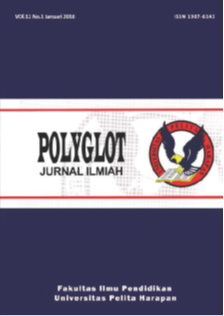The Implementation of Problem-Based Learning to Increase Students’ Conceptual Understanding According to a Christian Perspective
DOI:
https://doi.org/10.19166/pji.v12i1.381Schlagworte:
PBL, problem-based learning, conceptual understanding, Christian perspective, pemahaman secara konsepAbstract
In the world of education, it is important that the teacher considers knowledge that students gain in school that can be applied in various situations in a student’s life either during the course of their formal education or when facing real-life problems. The inability to apply knowledge is termed as a lack of conceptual understanding. The researcher hypothesized that Problem Based Learning (PBL) will overcome this problem. The aim of this research is to determine whether the implementation of PBL can increase student’s conceptual understanding and to discover effective ways to implement PBL in order to increase the student’s conceptual understanding. This research is Classroom Action Research and is two-cycle research where the researcher used written tests, questionnaires, interviews of teachers and students, teacher’s observation forms, and journal reflections as instruments to measure the student’s conceptual understanding and the implementation of PBL based on a Christian perspective. Based on the analysis and discussion, it can be concluded that the implementation of problem-based learning can increase the student’s conceptual understanding according to a Christian perspective.
BAHASA INDONESIA ABSTRAK: Dalam dunia pendidikan, sangatlah penting bagi seorang guru untuk memperhatikan bahwa pengetahuan yang sudah siswa pelajari di sekolah dapat diaplikasikan dalam berbagai situasi baik saat siswa di sekolah maupun ketika mereka diperhadapkan dengan masalah dalam kehidupan. Ketidakmampuan siswa untuk mengaplikasikan pengetahuan yang sudah didapatkan dapat disebut sebagai kurangnya penguasaan konsep. Peneliti memutuskan untuk menggunakan Metoda Pembelajaran Berbasis Masalah (MPBM) untuk mengatasi masalah ini. Tujuan dari penelitian ini adalah untuk menemukan apakah penerapan MPBM dapat meningkatkan penguasaan konsep siswa dan langkah-langkah efektif untuk menerapkan MPBM dengan maksud untuk meningkatkan penguasaan konsep siswa. Metode penelitian yang digunakan adalah Penelitian Tindakan Kelas (PTK) yang berlangsung selama dua siklus di mana peneliti menggunakan ujian tertulis, angket siswa, wawancara siswa, wawancara guru, lembar observasi guru, dan jurnal refleksi sebagai instrumen untuk mengukur penguasaan konsep siswa dan penerapan MPBM. Berdasarkan hasil analisis dan diskusi, maka dapat disimpulkan bahwa penerapan MPBM dapat meningkatkan penguasaan konsep siswa dalam mempelajari peluang secara perspektif Kristen.
Literaturhinweise
Arikunto, S. (1999). Dasar-dasar evaluasi pendidikan. Bumi Aksara: Jakarta.
Barclay, O. R. (1993). Akal budi Kristiani. Jakarta: Gandum Mas.
Barrows, H., & Tamblyn, R. (1980). Problem-based learning: An approach to medical education. New York: Springer.
Cheong, A., & Goh, C. (2002). Teachers' handbook on teaching generic thinking skills. Singapore: Prentice Hall.
Daryanto, H. (2008). Evaluasi pendidikan. Jakarta: PT. Rineka Cipta.
Djamarah, S. B. (2008). Psikologi belajar (2nd ed.). Jakarta: Rineka Cipta.
Duch, B., Groh, S., & Allen, D. (2001). The power of problem-based learning. Sterling, VA: Stylus Publishing.
Mulyasa, H. E. (2009). Praktik penelitian tindakan kelas. Bandung: Remaja Rosdakarya.
Ibrahim, M., & Nur, M. (2005). Pengajaran berdasarkan masalah. Surabaya: Universitas Press.
Jensen, P. (2002). The revelation of God: Contours of Christian theology. Downers Grove, IL: InterVarsity Press.
Knight, G. R. (2006). Philosophy & education: An introduction in Christian perspective. Berrien Springs, MI: Andrews University Press.
Levin, B. (2001). Energizing teacher education and professional development with problem-based learning. Alexandria, VA: Association for Supervision and Curriculum Development.
Nasution, S. (2008). Teknologi pendidikan. Jakarta: Bumi Aksara.
Pierce, J. W., & Jones, B. F. (1996). Problem based learning: Learning and teaching in the context of problems. DeKalb, IL: Northern Illinois University Press.
Quinn, P. (2009). Early category and concept development. New York: Oxford University Press.
Santrock, J. (2011). Educational psychology. New York: McGraw-Hill.
Savin-Baden, M., & Major, C. H. (2004). Foundations of problem-based learning. London: Open University Press.
Siregar, E., & Nara, H. (2010). Teori belajar dan pembelajaran. Jakarta: Ghalia Indonesia.
Slavin, R. (2006). Educational psychology: Theory and practice (8th ed.). Boston, MA: Pearson-Allyn & Bacon.
Tampubolon, S. (2014). Penelitian tindakan kelas: Sebagai pengembangan profesi pendidik dan keilmuan. Jakarta: Erlangga.
Tan, O. S. (2003). Problem-based learning innovation. Singapore: Thomson Learning.
Tan, O. S. (2009). Problem-based learning and creativity. Singapore: Cengage Learning Asia.
Trianto. (2009). Mendesain model pembelajaran inovatif-progresif: Konsep, landasan, dan implementasinya pada Kurikulum Tingkat Satuan Pendidikan (KTSP). Jakarta: Kencana.
Van Brummelen, H. (1998). Walking with God in the classroom. Seattle: Alta Vista.
Wiriaatmadja, R. (2009). Metode penelitian tindakan kelas. Bandung: Rosdakarya.
Downloads
Veröffentlicht
Ausgabe
Rubrik
Lizenz
Authors who publish with this journal agree to the following terms:
1) Authors retain copyright and grant the journal right of first publication with the work simultaneously licensed under a Creative Commons Attribution License (CC-BY-SA 4.0) that allows others to share the work with an acknowledgement of the work's authorship and initial publication in this journal.
2) Authors are able to enter into separate, additional contractual arrangements for the non-exclusive distribution of the journal's published version of the work (e.g., post it to an institutional repository or publish it in a book), with an acknowledgement of its initial publication in this journal.
3) Authors are permitted and encouraged to post their work online (e.g., in institutional repositories or on their website). The final published PDF should be used and bibliographic details that credit the publication in this journal should be included.





